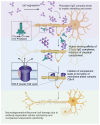Immunoglobulin G and Complement as Major Players in the Neurodegeneration of Multiple Sclerosis
- PMID: 39456143
- PMCID: PMC11506455
- DOI: 10.3390/biom14101210
Immunoglobulin G and Complement as Major Players in the Neurodegeneration of Multiple Sclerosis
Abstract
Multiple Sclerosis (MS) is an inflammatory, demyelinating, and neurodegenerative disease of the central nervous system (CNS) and is termed as one of the most common causes of neurological disability in young adults. Axonal loss and neuronal cell damage are the primary causes of disease progression and disability. Yet, little is known about the mechanism of neurodegeneration in the disease, a limitation that impairs the development of more effective treatments for progressive MS. MS is characterized by the presence of oligoclonal bands and raised levels of immunoglobulins in the CNS. The role of complement in the demyelinating process has been detected in both experimental animal models of MS and within the CNS of affected MS patients. Furthermore, both IgG antibodies and complement activation can be detected in the demyelinating plaques and cortical gray matter lesions. We propose here that both immunoglobulins and complement play an active role in the neurodegenerative process of MS. We hypothesize that the increased CNS IgG antibodies form IgG aggregates and bind complement C1q with high affinity, activating the classical complement pathway. This results in neuronal cell damage, which leads to neurodegeneration and demyelination in MS.
Keywords: IgG; complement; disease progression; multiple sclerosis; neurodegeneration; neurons.
Conflict of interest statement
The authors declare no conflict of interest.
Figures
Similar articles
-
Myelin-specific multiple sclerosis antibodies cause complement-dependent oligodendrocyte loss and demyelination.Acta Neuropathol Commun. 2017 Mar 24;5(1):25. doi: 10.1186/s40478-017-0428-6. Acta Neuropathol Commun. 2017. PMID: 28340598 Free PMC article.
-
Homogeneity of active demyelinating lesions in established multiple sclerosis.Ann Neurol. 2008 Jan;63(1):16-25. doi: 10.1002/ana.21311. Ann Neurol. 2008. PMID: 18232012
-
Complement is activated in progressive multiple sclerosis cortical grey matter lesions.J Neuroinflammation. 2016 Jun 22;13(1):161. doi: 10.1186/s12974-016-0611-x. J Neuroinflammation. 2016. PMID: 27333900 Free PMC article.
-
[Immunity and neurodegeneration: new concepts in multiple sclerosis].Rev Med Suisse. 2006 May 3;2(64):1166-8, 1170. Rev Med Suisse. 2006. PMID: 16734188 Review. French.
-
[Recent progress in multiple sclerosis research: astrocytopathy in demyelinating diseases].Rinsho Shinkeigaku. 2010 Nov;50(11):788-93. doi: 10.5692/clinicalneurol.50.788. Rinsho Shinkeigaku. 2010. PMID: 21921443 Review. Japanese.
References
-
- Wallin M.T., Culpepper W.J., Campbell J.D., Nelson L.M., Langer-Gould A., Marrie R.A., Cutter G.R., Kaye W.E., Wagner L., Tremlett H., et al. The prevalence of MS in the United States: A population-based estimate using health claims data. Neurology. 2019;92:e1029–e1040. doi: 10.1212/WNL.0000000000007035. - DOI - PMC - PubMed
Publication types
MeSH terms
Substances
Grants and funding
LinkOut - more resources
Full Text Sources
Medical


